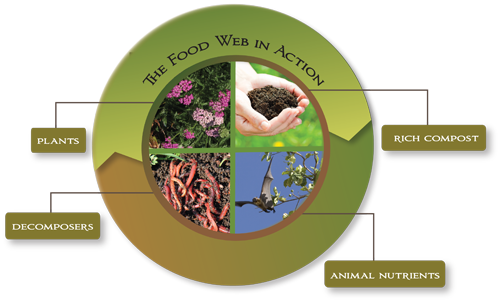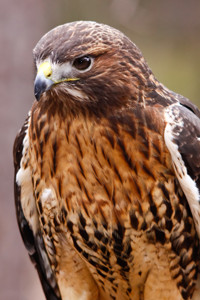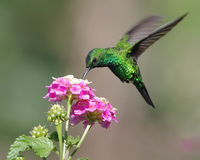Walk on the Wild Side
Using nature to balance out pests in a garden is a typical IPM practice. Living Green Gardens contains several features designed to attract beneficial insects, birds and insect-eating critters such as bats and lizards. Inviting certain types of wildlife to a Natural Garden is essential to controlling pests. Using wildlilfe who naturally eat these pests is a vital step in reducing toxic pesticide use. Trees and plants provide both food and shelter for wildlife.
Living Green Gardens features several habitat amenities, including a bat box, birdhouses and a raptor perch. Bats feed on small insects, and are crucial for controlling mosquito populations. Birdhouses are present for songbirds, who, along with small mammals, attract larger predators like raptors. Raptors have a place where they can perch and keep an eye out for their next meal. The most important wildlife habitat feature is all around you: the plants.
The Food Web in Action
Creating a garden that’s beneficial to wildlife starts from the ground up. Soil that’s rich in organic matter such as compost provides food for decomposer organisms — many of which provide symbiotic benefits for the producers in this food web: plants. These plants are the main source of food for consumers, or animals, who leave behind droppings, or, in some cases, their bodies, for the decomposers to transform back into nutrients, which keep the ecological cycle going.

Birdhouses
Birdhouses should be specifically designed for the bird species you wish to attract to your garden. The size of the entry hole determines the size of bird that the house will attract, as well as keep out larger birds that might destroy eggs and young. It’s important to supply clean, fresh water nearby with a birdbath, saucer, or pond. All wildlife needs water.
For ideas on building or selecting a nesting box visit the Natural Wildlife Federation.
Butterflies and Bees
Butterflies are attracted to a large variety of plants that produce nectar. Caterpillars, the larval stage of butterflies, need nourishment from different plants. Bees play a critical role in healthy gardens through pollination. A significant part of our diet is food produced through the pollination of fruits and vegetables. Use native plants in your garden to support pollinating insects as well as butterflies and birds. These plants provide the right food or nectar and are generally well adapted to our local climate.

The Peregrine Falcon is a beautiful bird of prey, and the fastest animal on Earth. In California, not too long ago, it was also one of the most endangered. Due to the pesticide DDT, widely used in the 60s, Peregrines and Bald Eagles lay thin-shelled eggs that broke in the nest during incubation.
With the banning of DDT and decades of work by Glenn R. Steward and the Santa Cruz Predatory Bird Research Group, peregrine falcons have undergone an incredible recovery.
Today, an estimated 250 to 300 peregrine pairs are living and nesting in California. Forty-five or 50 of these pairs live in the greater Bay Area, from Napa and Marin Counties south to Mount Hamilton. Living Green Gardens is visited by these majestic creatures who dine on smaller birds and reptiles.

Lantana flowers attract humming- birds, bees, and butterflies, all of which are pollinator species. Without these pollinators, many plants, including those that provide food for your dinner table, would be unable to bear fruit. You can help support these pollinators by planting nectar-producing plant species featured here to keep them pollinating!


